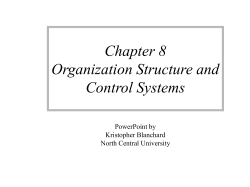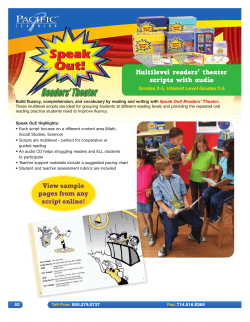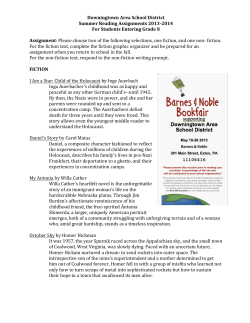
Reading with English Language Learners
Literature and Reading with English language learners PUCESE English Language Conference Esmeraldas, Ecuador 2014 Ali Cullerton, Ph.D. Qualities of Outstanding Literature ! Good books: ! Expand awareness ! Provide an enjoyable read that doesn’t overtly teach or ! ! ! ! moralize Tell the truth Embody quality Have integrity Show originality Genres of Literature ! Folktales ! Realistic fiction ! Fantasy ! Poetry ! Historical fiction ! Biography ! Information ! Graphic Novel How well do you know your genres of literature? Contemporary Realistic Fiction Folk Literature Easy Reader Concept Book Historical Fiction Informational Text Fantasy Science Fiction Biography Picture Book Multicultural Graphic Novel Multicultural Literature About people who are not in the mainstream (although there is no consensus on what constitutes mainstream). Culturally-authentic books are written by authors who have developed a “culturally conscious” way to “provide exceptional aesthetic experiences: to entertain, education inform; and …engender racial pride” (Harris, 1990). Good/Bad MT Insider/Outsider Perspective Stereotyping Criteria for Evaluating and Selecting Multicultural Literature Do the author and illustrator present authentic perspectives? Is the culture portrayed multi-dimensionally? Are cultural details naturally integrated? Is the collection balanced? Is language used authentically? Are details accurate and is the interpretations current? Who is the publisher? Has the book won any awards? Reading Literature in Secondary School “A PRIMARY function of literature in the secondary schools is to produce a particular kind of citizen-GLOBAL CITIZEN” ! Often, we think of YA literature and English Class comes to mind… ! “Back-to-basics” schooling defines reading in a very narrow- minded manner ! Teachers must account for the changing realities of the demographics in their classrooms and challenge notions of “common culture” Globalization ! Teaching and reading of literature in secondary school has been shaped by globalization. ! Classrooms can no longer be considered as bound sites, with students entering from fixed locations (Pennycook, 2005) ! Globalization creates a PULL/PUSH between its desired outcomes of standardization and diversification. Globalization ! We view globalization as a set of complex economic and cultural processes with both positive and negative implications on the teaching and learning of literature. ! Forces us to redefine who counts as a relevant, desirable and global citizen. ! Expands the interpretive positions that students take up in the study of literature. ! New technologies redefine the selection, genres and dissemination of literary texts Literature Resources http://www.alexiscullerton.com/book-lists.html Why might it be important to use genre-diverse literature in the classroom for learning a new language? Role Play ! Scenario #1: Public Speaking Unit. ! Scenario #2: Historical Lesson on World War II. ! Scenario #3: Personal narratives-essay writing. ! Scenario #4: Grammar Unit. Future tense. 1. Think of the objectives of the unit. 2. What type of genre might be a good fit and why? Ways to Support Reading for English language learners… Three principles of comprehension instruction EXPLICIT MORE KNOWLEDGEABLE OTHER SCAFFOLDED Comprehension strategies Background Knowledge: “What do I already know that helps me step into the world created by this text?” • Text-processing: “What can I do to make sense of the text as I move through this text world? • Monitoring strategies: “How do I know if the meanings I’ve created make sense? Background knowledge Concepts of print Developing vocabulary Making intertextual connections Making predictions Using context clues Text-processing strategies ! Sequencing ! Visualizing ! Identifying Key Events ! Making inferences ! Understanding literary elements ! Using genre knowledge ! Using perspective ! Using knowledge of text structure Monitoring strategies ! Evaluating and adjusting predictions ! Asking questions ! Clarifying inferences “He put down $10.00 at the window. The woman behind the window gave $4.00. The person next to him gave him $3.00, but he gave it back to her. So, when they went inside, she bought him a large bag of popcorn.” Inferences It was so cold I could barely feel my fingers. I stood there, rocking my legs back and forth and doing a little jump to keep my blood moving. Every so often I would walk out into the middle and look as far as I could to see if it was coming. Inferences ! When I walked inside, my eyes were drawn in a million different directions. There was too much to take in, my surroundings were magnificent. There were stone sculptures etched into the walls, ceilings so high I couldn’t even see where they ended and more detail than one could ever truly appreciate. Eventually, I made my way to the winding staircase and leaned against the wall. A couple speaking Catalan walked by, saying something I could not understand. But they too, the locals, were just as amazed as I was by our surroundings. In that moment, I started to understand how something could take over 100 years to build, how someone could commit their whole lives to one project, and it all made sense. La Sagrada Familia Making inferences (Durkin, 1993). ! Text Based: made from information that the author supplied in the text ! Knowledge-based: made from knowledge about the world ! We use inferences to create “internal text” (personal thoughts about what is happening in the text.) ! Readers construct internal texts as they connect the information in the “external text” (the printed information) with what they already know. Our goal is to use strategies so that students can connect the external text with the internal text. Remember we talked about EXPLICIT teaching? ! Strong readers make inferences, visualize and use many other strategies to comprehend the text in front of them. ! Struggling readers are not as good at using those strategies. ! As a teacher, it is your job to teach and model the strategy so that students can learn to do it on their own. Questions? references ! Children’s Books in Children’s Hands: An Introduction to Their Literature by: Charles Temple, Miriam Martinez and Junko Yokota ! Reading Literature in Secondary School: Disciplinary Discourses in Global Times by: Cynthia Lewis and Jessica Dockter
© Copyright 2025




















